
- Homepage
- Amplifier Type
- As Description (11)
- Attenuator (9)
- Cabinet (737)
- Cabinets (15)
- Combo (1024)
- General (12)
- Guitar (37)
- Guitar Amp Combo (7)
- Guitar Amplifier (19)
- Guitar Speaker (13)
- Head (97)
- Not Specified (22)
- Solid State (9)
- Speaker (87)
- Speaker Amplifier (9)
- Speaker Cabinet (8)
- Stack (36)
- Subwoofer (8)
- Tube (24)
- Various (20)
- Other (1759)
- Brand
- Model
- 5e3 (6)
- Ac-15 (25)
- Ac-25 (13)
- Acoustage (7)
- Adio Air Gt (11)
- Bc108 (6)
- Celestion G12t-75 (14)
- Cube Street Ex (7)
- Fly 3 (13)
- G12m (7)
- G12m-65 (7)
- Jazz Chorus (6)
- Peavey Vypyr X 2 (6)
- Spark Go (7)
- Super Reverb (14)
- Twin Reverb (9)
- Vintage 30 (14)
- Vox Brian May Mv50 (7)
- Yamaha Thr10ii (8)
- 122190 (6)
- Other (3770)
- Product Line
- Blackstar Fly 3 (6)
- Celestion (6)
- Celestion G 12 V 30 (6)
- Celestion G12t-75 (13)
- Crush (6)
- Deluxe (49)
- Guitar Amplifier (6)
- Max (7)
- Pathfinder (11)
- Peavey (7)
- Roland Cube (6)
- Roland Jc (8)
- See Description (11)
- Spark 40 (7)
- Spider (13)
- Thr Series (28)
- Unknown (9)
- Vox (7)
- Vox Amplug 2 (10)
- Vox Nutube (7)
- Other (3740)
- Suitable For
- Type
- Amp (6)
- Amplifier (11)
- Amplifier Board (5)
- Bass Amplifier (11)
- Cabinet (10)
- Dust Cover (5)
- Electric Guitar (22)
- Guitar Amplifier (6)
- Guitar Amplifiers (13)
- Guitar Speaker (96)
- Hard Case (5)
- Instrument Amplifier (20)
- Leslie Speaker (6)
- Replacement Speaker (5)
- Speaker (68)
- Speaker Cabinet (6)
- Speaker Cabinets (125)
- Speaker Horn (24)
- Woofer (4)
- Zo-3 Guitar (7)
- Other (3508)
70s Yamaha RA-50 Green Rotary Speaker Amplifier LeslieStyle Japan free shiping
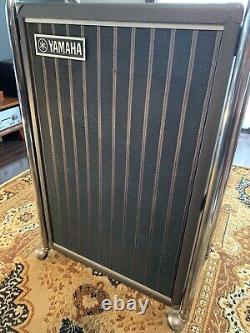
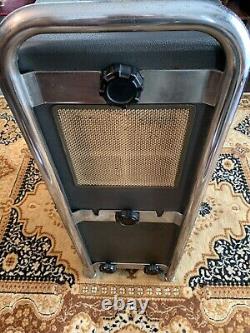

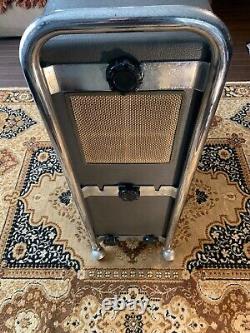
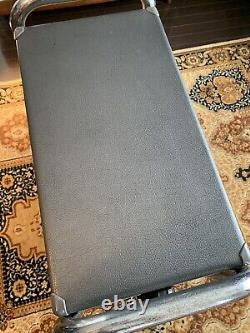
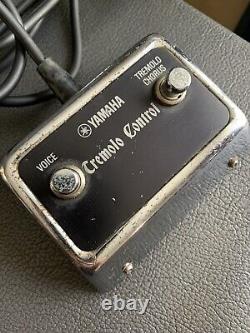


Now, here's something you don't see every day. They were produced by Yamaha in the early 1970s, but aimed at a rather different market than most Leslie-type speakers as they came from the Yamaha guitar department. Several guitarists had been experimenting with organ Leslie speakers, notably Jimi Hendrix, but proper Leslie speakers are huge and heavy and the input impedance isn't really right for just plugging in a guitar directly, So this was designed to be more guitarist-friendly. This model consists of a fairly standard 50 watt transistor amplifier, a main driver speaker at the bottom, and a rotary speaker at the top which, unlike most Leslie speakers, is mounted vertically like a Ferris wheel rather than horizontally.
There are two extra speaker grilles on the sides near the top to let the rotary sound out. The control panel is on the back at the top and is pretty basic. Volume, bass and treble controls for the amp and tremolo speed. There's a big round socket for connecting to a second passive unit without the amplifier (although I'm not sure if they ever built any of those) and a pedal socket.
There was also a 100 watt and a 200 watt version, in fact Dave Gilmour used the RA-200 version with Pink Floyd well into the late 1980s. Sounds rather flaccid but still, each to their own! So if it's such an ordinary amplifier, why does it sound so wonderful? Well, the inside is full of surprises. Starting at the bottom there's the amplifier - nothing to see here really.
Bog standard 70's transistor design built onto a valve-style chassis. But then you come to the main driver, and it's square, and very shallow - almost flat, and white, and with a vinyl cone. Now that's a bit different.
The combination of that amp and speaker on it's own makes for a very pleasing bright guitar sound. Admittedly there's no overdrive available, but don't forget this was the heyday of the fuzz box, so that wasn't really a problem. The glue holding the cone to the frame has discoloured a bit, but it's all holding out just fine, better than most 45 year old speakers!
Moving up to the shelf above we get to where the magic happens.. There's quite a lot of rather exquisite heavy engineering going on here. The actual speaker is the white thing looking a bit like a sandwich box sticking out from the left hand side of the triangular bit, and now I get to use one of my favourite words - that triangular bit is called a trunion : Sticking out the other side you can see the square metal counterweight which has been machined to be exactly the same weight as the speaker. Even after all this time the whole unit needs nothing doing to it apart from a bit of cobweb removal. All the bearings are heavy duty bronze and self-lubricating, the motor is a work of art and in perfect condition, and the whole thing runs smoothly and silently.
I attach a hard case and deliver it.
